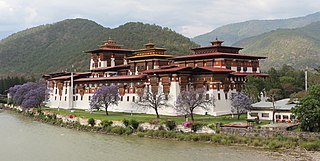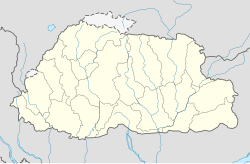
Bhutan's early history is steeped in mythology and remains obscure. Some of the structures provide evidence that the region has been settled as early as 2000 BC. According to a legend it was ruled by a Cooch-Behar king, Sangaldip, around the 7th century BC, but not much is known prior to the introduction of Tibetan Buddhism in the 9th century, when turmoil in Tibet forced many monks to flee to Bhutan. In the 12th century, the Drukpa Kagyupa school was established and remains the dominant form of Buddhism in Bhutan today. The country's political history is intimately tied to its religious history and relations among the various monastic schools and monasteries.

Thimphu is the capital and largest city of Bhutan. It is situated in the western central part of Bhutan, and the surrounding valley is one of Bhutan's dzongkhags, the Thimphu District. The ancient capital city of Punakha was replaced by Thimphu as capital in 1955, and in 1961 Thimphu was declared as the capital of the Kingdom of Bhutan by the 3rd Druk Gyalpo Jigme Dorji Wangchuck.

Dzong architecture is used for dzongs, a distinctive type of fortified monastery architecture found mainly in Bhutan and Tibet. The architecture is massive in style with towering exterior walls surrounding a complex of courtyards, temples, administrative offices, and monks' accommodation.
The Drukpa or Drukpa Kagyu lineage, sometimes called Dugpa in older sources, is a branch of the Kagyu school of Tibetan Buddhism. The Kagyu school is one of the Sarma or "New Translation" schools of Tibetan Buddhism. The Drukpa lineage was founded in the Tsang region of Tibet by Tsangpa Gyare (1161–1211), and later became influential in Ladakh and Bhutan. It is one of several lineages known as "Red Hat sects".

Ngawang Namgyal and known colloquially as The Bearded Lama, was a Tibetan Buddhist lama and the unifier of Bhutan as a nation-state. In addition to unifying the various warring fiefdoms for the first time in the 1630s, he also sought to create a distinct Bhutanese cultural identity separate from the Tibetan culture from which it was derived.
Articles related to Bhutan include:

Zhabdrung was a title used when referring to or addressing great lamas in Tibet, particularly those who held a hereditary lineage. In Bhutan the title almost always refers to Ngawang Namgyal (1594–1651), the founder of the Bhutanese state, or one of his successive reincarnations.

Punakha is the administrative centre of Punakha dzongkhag, one of the 20 districts of Bhutan. Punakha was the capital of Bhutan and the seat of government until 1955, when the capital was moved to Thimphu. It is about 72 km away from Thimphu, and it takes about 3 hours by car from the capital. Unlike Thimphu, it is quite warm in winter and hot in summer. It is located at an elevation of 1,200 metres above sea level, and rice is grown as the main crop along the river valleys of two main rivers of Bhutan, the Pho Chu and Mo Chu. Dzongkha is widely spoken in this district.

The Catholic Church in Bhutan is part of the worldwide Catholic Church, under the spiritual leadership of the Pope in Rome. The Kingdom of Bhutan falls under the jurisdiction of the Diocese of Darjeeling (India).

Rinpung Dzong, sometimes referred to as Paro Dzong, is a large dzong - Buddhist monastery and fortress - of the Drukpa Lineage of the Kagyu school in Paro District, Bhutan. It houses the district Monastic Body as well as government administrative offices of Paro Dzongkhag. It is listed as a tentative site in Bhutan's Tentative List for UNESCO inclusion.

Drukgyel Dzong was a fortress and Buddhist monastery, now in ruins, located in the upper part of the Paro District, Bhutan. The dzong was probably built by Tenzin Drukdra in 1649 at the behest of Zhabdrung Ngawang Namgyal, to commemorate victory over an invasion from Tibet.

Chagri Dorjeden Monastery, also called Cheri Monastery, is a Buddhist monastery in Bhutan established in 1620 by Ngawang Namgyal, 1st Zhabdrung Rinpoche, the founder of the Bhutanese state.

The Second Tibetan Invasion of Bhutan or the Second Battle of Simtokha Dzong was a military confrontation in 1634 between the supporters of Zhabdrung Ngawang Namgyal and the forces of the Tibetan Tsangpa dynasty and several Bhutanese lamas allied against him. The latter initially conquered Zhabdrung's seat, Simtokha Dzong, threatening to eliminate his young dominion. The castle's ammunition stores were accidentally ignited during the battle, however, resulting in an explosion that destroyed Simtokha Dzong and much of the Tibetan army. Seizing this chance, Zhabdrung's followers rallied and ousted the Tibetans from their territory, turning the battle into a decisive strategic victory of Ngawang Namgyal, paving the way for the Unification of Bhutan under his rule.
The Druk Desi was the title of the secular (administrative) rulers of Bhutan under the dual system of government between the seventeenth and nineteenth centuries. Under this system, government authority was divided among secular and religious administrations, both unified under the nominal authority of the Zhabdrung Rinpoche. Druk, meaning 'thunder dragon', refers symbolically to Bhutan, whose most ancient name is Druk-yul. Desi, meaning 'regent', was the chief secular office in the realm under this system of government.

The Penlop of Trongsa, also called Chhoetse Penlop, is a Dzongkha title meaning "Governor of the Province of Trongsa (Chhoetse)". It is now generally given to the heir apparent of the Kingdom of Bhutan, but historically was an important title, for the governor of Trongsa and the surrounding area, and was the route by which the House of Wangchuck came to the throne.

The Punakha Dzong, also known as Pungthang Dewa chhenbi Phodrang, is the administrative centre of Punakha District in Punakha, Bhutan. Constructed by Ngawang Namgyal, 1st Zhabdrung Rinpoche, in 1637–38, it is the second oldest and second-largest dzong in Bhutan and one of its most majestic structures. The dzong houses the sacred relics of the southern Drukpa Lineage of the Kagyu school of Tibetan Buddhism, including the Rangjung Kharsapani and the sacred remains of Ngawang Namgyal and the tertön Pema Lingpa.
Geshey Gendün Rinchen was the 69th Je Khenpo of Bhutan.
Pagsam Wangpo, a key figure in the history of the Drukpa Lineage of Tibetan Buddhism, was born at Chonggye, in the Tsang province of Tibet a natural son of the prince of Chonggye, Ngawang Sonam Dragpa. He was an elder cousin of the 5th Dalai Lama, Ngawang Lobzang Gyatso (1617-1682).

Dobji Dzong is a dzong monastery in Bhutan, on a ridge on the national highway from Thimphu to Haa, Paro District. It was built by Drukpa Kuenley's brother, Lam Ngawang Chogyel, in 1531. Today the dzong houses a monastic school with 35 monks. It was featured in the 2003 film Travellers and Magicians.

















